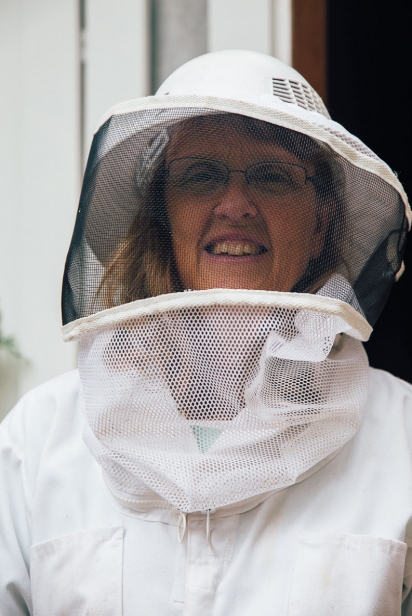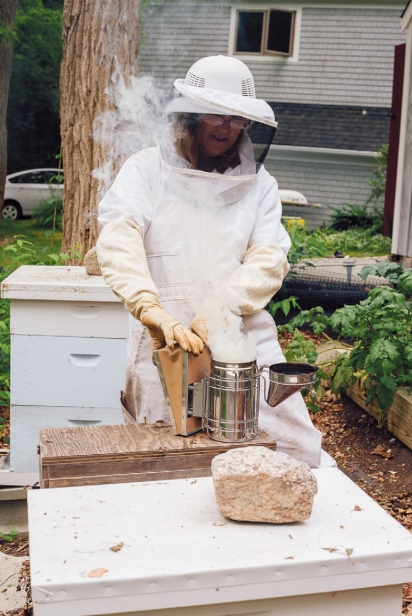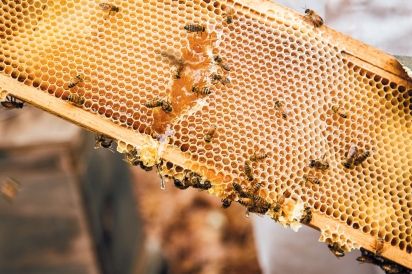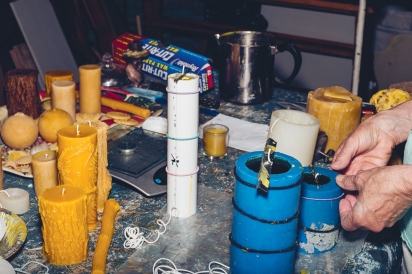The Backyard Bee Keeper
As a child, Anne Richards decided she was going to be a naturalist when she grew up. These days she bicycles around town and often bikes to work in Woods Hole. At her Falmouth home, she has thriving vegetable gardens, beehives and has tried making mead from her honey. She sells honey and handmade beeswax candles through her small Annie’s Apiary business. She has embraced a simple sustainable lifestyle, which has become popular with a generation of young homesteaders. However, Richards is 64 years old, holds a PhD in marine science, and is the mother of two grown children. Her husband is also a marine scientist and their yard has all the signs of Cape life well lived with kayaks, a small motor boat, an outdoor fire pit and plenty of seating, which all seem to invite outdoor enjoyment. Richards’ lifestyle is intentional and authentic and she seems to embrace all aspects of it with childlike awe and enthusiasm.
“It’s really interesting and you learn something all the time, every time you go into the hive,” she says of her bees. “I feel like they’re always challenging me and teaching me and they’re just really cool and I’ve developed this great appreciation for them!” Richards is a hobbyist beekeeper, but she is first and foremost a scientist, and her inquisitive mind and background in animal behavior have contributed to her fascination and success with the hives she keeps. She is a research biologist for the Northeast Fisheries Science Center of the National Oceanic and Atmospheric Administration (NOAA).
“In a sense you can consider the hive to be the organism, its called a super organism and the bees themselves can be considered the cells of the organism because each bee on its own can’t survive. The queen can’t survive by herself, the workers can’t survive by themselves, it’s all this integrated thing. And so when a hive swarms and a lot of the bees leave, that’s that super organism reproducing itself. They’ve got the little reproduction inside where the eggs and larvae are, but the reproduction of the hive is when they split off and part of it leaves. So a successful hive is one that can build up and get strong enough that it can throw off a swarm and go out and find another home,” Richards explains.
In spring and summer, Richards’ garden flourishes with asparagus, currents, raspberries, strawberries, peas, spinach, lettuce, kale, potatoes, sweet potatoes and the three sisters (corn, beans and squash). Her three hives are on one edge of the garden, providing the bees with easy access to the plants as well as several producing fruit trees and the purple-flowering ajuga that grows wild in the yard, although bees can forage up to five miles. Each fall, Richards posts a sign along Route 28 asking for bags of leaves. She spreads the sixty to a hundred bags that neighbors drop off over her gardens to fertilize and mulch the soil. By the following spring, even the thick oak leaves have broken down into little pieces that keep down the weeds, but allow her new crops to sprout up through them.
Richards was introduced to beekeeping in the 1980s when she helped a friend care for the bees at the Ashumet Holly Reservation. “We weren’t very successful,” she says, “in fact, one time they attacked us so hard that we just turned around and ran and left the hive open!” The thick denim of her pants protected her from getting stung that day by the pulsating stingers that covered her legs. The pair decided that perhaps the bees had backcrossed with wild bees that were still around at the time. The colonists first brought honeybees to North America from Europe. Wild populations formed when swarms of domesticated bees moved into hollow trees or other natural accommodations. Other types of bees and wasps are native to North America.
Twenty years after fleeing the aggressive bees at the holly reservation, Richards decided to sign up for a beekeeping class offered by the Barnstable County Beekeepers Association, “on a whim.” She signed up for her hive equipment at her first class and has now kept bees for twelve years. “I don’t think I realized until I started [beekeeping] how fascinating it would be, and also, it’s kind of relaxing.” She says picking apart the hive was intimidating at first, but for the most part the bees are calm when she is. She likes the smell that lingers on her hands, even though she wears gloves while tending her hives.
During the winter months Richards reads about bees and says there is always more to learn. “There are different philosophies about beekeeping and approaches…so you kind of try different things.” With more hives she would see greater variation and learn more quickly, but she also has a family, a full time job and other hobbies, which include singing and dancing. With three hives, she says, “I really do have to read and take advantage of other people’s experiences.” Throughout the past year she has also helped with the hives at nearby Pariah Dog Farm.
The Beekeepers Association, or bee club as Richards calls it, is a forum for bee enthusiasts. They offer speakers on different topics related to beekeeping and discussion periods “where people who are really experienced talk about their tricks for harvesting honey or overwintering their bees.” Membership in the bee club has more than doubled to over 300 since Richards joined in 2005 and the introductory class she took now has a waiting list. There is increasing public concern for bees and new research is being done on bees as pollinators, and on apitherapy, which includes the medicinal use of honey, pollen, propolis, royal jelly and bee venom.
Every summer Richards volunteers at the bee club’s beekeeper’s hut at the Barnstable County Fair. They sell honey and candles and have a demonstration hive, which is a single frame in glass so visitors can observe the honeycomb and bees. Richards loves telling people how “amazing and organized bees are.” In late fall and early winter the bees keep the hive temperature in the 70s by forming a cluster around the queen and moving and flapping their wings to build heat. January through March, after the queen begins laying eggs, they keep the hive temperature between 92 and 94 degrees.
“It’s really interesting and it’s a creative thing, even though I’m not creating them, I’m sort of involved in their creative process,” Richards says of her role as beekeeper. She also gets creative with the beeswax candles she makes and sells along with her honey. It was hard to find beeswax candles when she started making them eight years ago and she says that people really appreciate them as a gift they can use. She enjoys the process of threading the wicks, melting the wax, pouring the candles and experimenting with what objects will work as molds, what designs will burn well and the often-fickle aesthetics of what customers will like.
Richards’ basement candle making studio has a melting pot; work table strewn with candles and molds; display shelf made from part of an old dresser; prototypes, tests, repairs and finished items; and shoe boxes full of objects to make molds out of, including branches, shells and gourds found in nature and demitasse cups, perfume bottles and salt shakers collected from thrift stores. She purchases most of her wax in ready-to-use bricks of varying shades from caramel-brown to muted yellow and she purifies and uses additional wax from her own hives. She also experiments with using the green slow- and even-burning wax from bayberries that Colonial New Englanders used. Much like her beekeeping, Richards’ candle making is a process of trial and error, creativity, experimentation and learning. Her daughter likes candle making too and a delicate beeswax bowl inlaid with pressed flowers that she made sits in a collection of finished pieces.
Every holiday season Richards sells her Annie’s Apiary honey and candles at the Renaissance Fair in Woods Hole. Her candles and honey are also available for purchase at the ByWay Barber and her honey at Cape Cod Bagel Cafe, both located in Falmouth and open year round. “I never wrap my candles and the first thing that people do is they pick it up and they smell it.” She adds, “there’s something when you inhale the smell of beeswax, its almost like you’re having a feast.”
In an effort to keep the scale of her operation small and enjoyable, Richards does not participate in many fairs and avoids doing mail order. She gives away honey and candles as presents and uses them in her own home where her family drinks honey in tea and she loves to eat it on toast with butter. She also tries out different recipes for cakes and breads that incorporate honey and has made elderflower wine with it as well as the mead. This year Richards did not harvest any honey in an effort to build up her hives for the winter. There have been other years when she did not get honey, but in 2015 she harvested around 115 pounds, which included spring honey after the extremely cold winter and bursting spring bloom. Normally she harvests only in September. The different pollens in each season vary the color from golden spring honey to rich, dark amber in autumn.
There are endless variables and trials of beekeeping. Richards says the biggest challenge is being observant enough “to develop the ability to see and be able to interpret what that means…. And be able to do something about it, if you need to.” She adds that, “mites are a huge challenge. Getting your bees to survive the winter is a big deal and that relates to mites, but that fits into the whole thing of understanding what’s going on.”
Two years into beekeeping Richards was stung on her carotid artery and had an allergic reaction that landed her in the emergency room. Unwilling to give up beekeeping, she underwent treatment after experiencing a second allergic reaction to a sting. “They inject you with bee venom and at first you go every week and they start you with maybe a tenth of a sting’s worth and increase the dose up to the equivalent of two bee stings and then you go once a month.” After five years of treatment, she was tested again and did not have a reaction. She hardly gets stung anymore and when she does it is not a full sting because she wears better protective clothing and can pull the material of her suit and the stinger away from her body. Some beekeepers purposefully tend their hives without gloves to benefit from the anti-inflammatory properties of bee venom that purportedly prevent arthritis.
Richards notes that, “beekeeping is a culture unto itself.” It has a lot of tradition and specific terminology. She describes it as a “little stratum in society, there’s a thin layer running across society that is beekeepers… its very distinct.”









